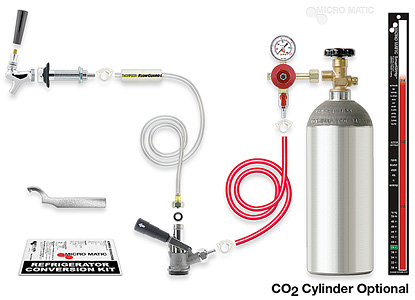I know everyone is bias to home brew. I do plan on home brewing after i upgrade. But the little woman drinks Bud lite and I have to get this straight first.
I had a kegerator 20 years ago and just rebuilt it and was lost on how to tap it. <I know how to tap it, but adding the co2 is the hard part>
I searched and found this from chuggs:
1) Let the keg settle a while, and get it nice and iced down.
2) Find a volunteer (never had a shortage of these at a kegger)
3) Now connect your Sankey Coupler and pull the split ring on the pressure relief valve...and let most all of the CO2 out...but not completely.
4) Set your regulator down to 0 psi...but have a screwdriver on it ready to go.
5) Now, give your volunteer a really big mug, or a pitcher and have them start pouring a beer.
6) Watch the flow, as you dial up the PSI on your CO2 regulator. When the pour flows smoothly...you're set.
7) Important!! When you're done serving...Be sure to dail up the CO2 pressure in the keg to 12-14 psi to keep your beer from going flat. Then disconnect the Sankey Coupler.
***
1. Is the Coupler the Tap? If so I have a D System for North American Beers
2. My question is on number 7:
I don't have a sankey coupler and does this matter I have a standered D System. so the pressures always on. If i dial up the pressure in the end... why am i adjusting it to a good beer flow? why not just set it at 12-14?
3. Whats the difference between a sankey and a D system?
4. 24 hours after tapping it's still mostly head. Although Ive only poured about 6 mugs of it so far. The lady at the bar said just run it for 3 minuets till it runs clear then your good. I don't really want to waste all that beer. Will it calm down on its own?
Thanks

I had a kegerator 20 years ago and just rebuilt it and was lost on how to tap it. <I know how to tap it, but adding the co2 is the hard part>
I searched and found this from chuggs:
1) Let the keg settle a while, and get it nice and iced down.
2) Find a volunteer (never had a shortage of these at a kegger)
3) Now connect your Sankey Coupler and pull the split ring on the pressure relief valve...and let most all of the CO2 out...but not completely.
4) Set your regulator down to 0 psi...but have a screwdriver on it ready to go.
5) Now, give your volunteer a really big mug, or a pitcher and have them start pouring a beer.
6) Watch the flow, as you dial up the PSI on your CO2 regulator. When the pour flows smoothly...you're set.
7) Important!! When you're done serving...Be sure to dail up the CO2 pressure in the keg to 12-14 psi to keep your beer from going flat. Then disconnect the Sankey Coupler.
***
1. Is the Coupler the Tap? If so I have a D System for North American Beers
2. My question is on number 7:
I don't have a sankey coupler and does this matter I have a standered D System. so the pressures always on. If i dial up the pressure in the end... why am i adjusting it to a good beer flow? why not just set it at 12-14?
3. Whats the difference between a sankey and a D system?
4. 24 hours after tapping it's still mostly head. Although Ive only poured about 6 mugs of it so far. The lady at the bar said just run it for 3 minuets till it runs clear then your good. I don't really want to waste all that beer. Will it calm down on its own?
Thanks







 :rockin:
:rockin:
 :cross: see ya
:cross: see ya